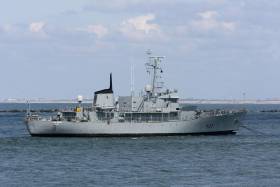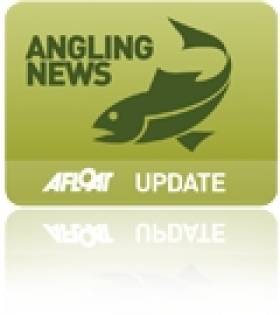Displaying items by tag: Netherlands
#AvenhornArrives – Former Naval Service OPV LÉ Aisling under her new name Avenhorn arrived in Dutch waters following a five-day towage delivery voyage, writes Jehan Ashmore.
The operation began on Sunday to tow Avenhorn from Cork Harbour from where the oldest unit of the navy dating to 1980 had been laid-up in the Naval Basin on Haulbowline.
The final 'Emer' class OPV built by Verolme Cork Dockyard had served the navy for 36 years until decommissioned last year in her adopted homeport of Galway.
Bere Island based tug Ocean Bank which at 33m is more than half the length of Avenhorn arrived on Thursday to navigate the New Waterway (Nieuwe Waterweg). The canal connects the North Sea and the Port of Rotterdam.
Last month Dutch shipbroker, Dick van der Kamp Shipsales B.V. bid for the vessel that was sold at public auction for €110,000 through auctioneer Dominic Daly.
The new owners plan to refurbish Avenhorn which is registered in Belize and then place the vessel for re-sell.
Ireland Take Bronze in 2012 Shore Angling Worlds
#ANGLING - Ireland's shore angling team have taken the bronze medal at the 2012 World Shore Angling Championship held at Veere in the Netherlands.
Brian Cooke of the Irish Federation of Sea Anglers (IFSA) reports that the fishing was very tough over the week, with anglers casting into a shipping channel that contained tackle grabbing ledges.
The predominant species were dabs to 30cm, whiting, pouting and some lovely soles, he says, noting that the weather was very changeable, and gales combined with big tides to test the resolve of the competitors. Most fish were taken at distance and zones were won with 15-25 fish.
The Irish team improved their position each day, finishing seventh on day 1 and moving up to fifth and fourth on succeeding days.
Coming into the final session, the Irish needed to close a four-point gap on the Italian team in third, which Cooke describes as "a massive gap to overturn in this event given the quality of the opposition".
But the Irish team pulled it off, says Cooke, "using all their experience and skills to leapfrog the Italians and claim another World Championship medal for an Irish Shore team.
"The qualification pool system has certainly proved a success, this medal adding to the gold won by Ireland in South Africa in 2010," he adds. Cooke congratulated team manager Tom Lillis and the six-man squad: Martin Howlin, Joe Duggan, John O’ Brien, Derek Kenrick, Eugene Farrelly and Kieran Begadon.
50 Facts About the Tall Ships Races 2011
Ahead of the Tall Ships Races in Waterford which begin tomorrow, Waterford Today presents 50 facts you may not be aware of regarding the annual event and its host city for 2011.
Did you know, for instance, that Waterford was once home to some of the most sophisticated shipbuilding operations of the 19th century, and was this country's leading location for iron shipbuilding from the mid-1840s to the early 1860s?
Or that the 55-metre barque Europa, from the Netherlands, is celebrating 100 years afloat in 2011?
Waterford Today has more interesting facts about this year's races HERE.
Stealth Frigates to Visit Dublin Port
Two Dutch naval frigates, HNLMS Tromp and HNLMS Van Amstel are due to arrive into Dublin Port tomorrow for a courtesy visit over the weekend, writes Jehan Ashmore.
The Royal Netherlands Navy HNLMS Van Tromp is a De Zeven Provinciën-class air-defence and command frigate (LCF). The class has a striking streamlined visual appearance, through the use of stealth design technology. The stealth design is to minimise the vessels signature as much as possible from the detection of enemy vessels using radar.
At 6,050 tonnes, the stealth frigate is one of five built by the Royal Schelde Group, of Flushing, Netherlands. Spain and Germany also participated during the design stage of the 144-metre class which are powered by gas turbine engines capable of reaching 30 knots.
They are equipped with an Oto Breda 127 mm cannon, vertical launch system (VLS) Mk 41 for Evolved Sea Sparrow Missile (ESSM), Standard Missile and Harpoon Missiles. In addition the frigate has a Goalkeeper (rapid-fire gun), a Oerlikon 20 mm machine gun and a Mk. 46 Torpedo weapon system. The vessel also has the ability to carry a Lynx or NH-90 helicopter.
The second frigate to visit the capital is HNLMS Van Amstel, one of two multi-purpose M-class frigates. The frigate which is also known as the Karel Doorman class can be used for surface warfare and anti-submarine warfare. They also have their own air-defence capabilities.
The 122-metre vessels displace 3,300 tonnes and have a two Rolls Royce (Spey 1A) gas turbines delivering 29 knots. The class are equipped with an array of defence / attack armament to includes an Oto Melara 76 mm gun for surface and air targets, a Harpoon weapon system and a NATO Sea Sparrow Vertical Launch weapon system for use against air targets at close range. Like the De Zeven –class the M-class frigate is also capable of carrying a Lynx helicopter.
































































